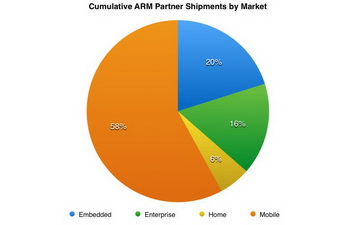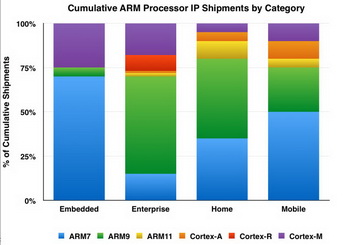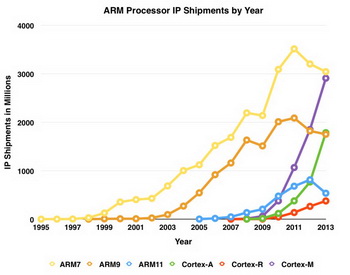OOPS! You forgot to upload swfobject.js ! You must upload this file for your form to work.
During 23 years was produced 50 billion ARM chips
![]()
|
xtreview is your : Video card - cpu - memory - Hard drive - power supply unit source |
|
|||
|
|
||||
 Recommended : Free unlimited image hosting with image editor
Recommended : Free unlimited image hosting with image editor
|
POSTER: computer news || DURING 23 YEARS WAS PRODUCED 50 BILLION ARM CHIPS |
DATE:2014-04-01 |
|
|
During 2013 alone, ARM licensees have released 10 billion chips using the same name cores . In the entire history of ARM company , licenses for popular architecture company began to issue in 1991, the market delivered 50 billion different chips. As you can see, the bulk of the products went in recent years due to the demand for mobile phones, smartphones and tablets. ARM company in not in hurry to share details about these or other licensees.  Let's start with a rough division of ARM cores on the main sectors. As can be seen from the diagram above, the lion's share of products using ARM cores have to the mobile sector. It is not only computing cores, but also the core for modems and controllers. Following are embedded solutions and a little less corporate. This is not necessarily SoC, which time for the server segment is just beginning, and, for example, controllers for hard drives and solid state and more. Least of all ARM cores falls on home solutions presented TV consoles and some straightforward electronics.  Another interesting point was the information about the relationship of supply decisions on major core ARM. Easy to see that two-thirds of all the cores - it's old core ARM7 and ARM9. Architecture ARM11, on which came first smartphones Apple, more noticeable mark left on the market for home electronics devices, whereas in niche mobile devices proved much better architecture Cortex-A. Architecture Cortex-M - solution for microcontrollers and industrial automation - the best way to mark the embedded market and in corporate devices. Separately in corporate decisions noticeable surge of interest to the core Cortex-R, the potential of which is revealed in the active network equipment (routers and access points) and storage systems (RAID-controllers).  Finally, we see a more detailed timetable for the delivery of various core data. Delivery solutions for ARM7 and ARM9 cores stopped growing after 2011. They were replaced by more specialized and modern core Cortex-M and Cortex-R, with the first marked the most impressive growth rates in the history of ARM. Related Products : | ||
|
|
||
|
xtreview is your : Video card - cpu - memory - Hard drive - power supply unit source |
|
|
|
|
||
|
Xtreview Support  N-Post:xxxx Xtreview Support        |
DURING 23 YEARS WAS PRODUCED 50 BILLION ARM CHIPS |
| Please Feel Free to write any Comment; Thanks  |
MediaTek announces 8-core 16-nm mobile chips Helio P23 and Helio P30 (2017-08-30)
Samsung Galaxy Note 8 will be presented on August 23 and will receive three colors (2017-07-24)
In the second quarter, Xiaomi sold 23 million smartphones (2017-07-10)
Ryzen 5 1600X at the frequency of 5230 MHz became the second among the six-core in Geekbench3 (2017-05-29)
GeForce GTX 1080 Ti at 2375-12800 MHz using liquid nitrogen (2017-05-12)
NVIDIA Titan Xp managed to overclock to 2232-10400 MHz with the help of a water block (2017-04-19)
Quad GeForce GTX 1080 Ti overclocked to 2354-12608 MHz (2017-03-28)
NVIDIA Titan X MHz overclocked to 2319-10600 (2017-01-24)
Budget LG X230 received a Bluetooth SIG certification (2017-01-23)
Core i7-7700K Kaby Lake at a frequency of 7023 MHz (2016-12-25)
NVIDIA Titan X in Catzilla at frequencies 2392-11712 MHz (2016-12-25)
MediaTek introduced the 10-core processors Helio X23 and Helio X27 (2016-12-02)
NVIDIA Titan X MHz at frequencies 2350-11600 established two new records (2016-09-30)
Coolpad introduce a new Android-smartphone September 23 (2016-09-15)
Overclocked to 2350-11800 MHz GeForce GTX 1080 helped took silver in Catzilla 720p (2016-09-11)
Tizen-smartphone Samsung Z2 debut in India on August 23 (2016-08-22)
iPhone 7 and iPhone 7 Plus will go on sale September 23 (2016-08-17)
Dual GeForce GTX 1080 updated record Unigine Heaven Xtreme MHz at frequencies 2300-10800 (2016-07-29)
GeForce GTX 1080 duo was overclocked to 2354-11016 MHz (2016-07-18)
GeForce GTX 1080 MHz 2354-11016 frequencies helped to take third place in the Unigine Heaven Xtreme (2016-07-14)
![]()
To figure out your best laptops .Welcome to XTreview.com. Here u can find a complete computer hardware guide and laptop rating .More than 500 reviews of modern PC to understand the basic architecture


7600gt review
7600gt is the middle card range.
We already benchmarked this video card and found that ...

 geforce 8800gtx and 8800gts
geforce 8800gtx and 8800gts  Xtreview software download Section
Xtreview software download Section  AMD TURION 64 X2 REVIEW
AMD TURION 64 X2 REVIEW  INTEL PENTIUM D 920 , INTEL PENTIUM D 930
INTEL PENTIUM D 920 , INTEL PENTIUM D 930  6800XT REVIEW
6800XT REVIEW  computer hardware REVIEW
computer hardware REVIEW  INTEL CONROE CORE DUO 2 REVIEW VS AMD AM2
INTEL CONROE CORE DUO 2 REVIEW VS AMD AM2  INTEL PENTIUM D 805 INTEL D805
INTEL PENTIUM D 805 INTEL D805  Free desktop wallpaper
Free desktop wallpaper  online fighting game
online fighting game  Xtreview price comparison center
Xtreview price comparison center Lastest 15 Reviews


Rss Feeds
Last News
- The new version of GPU-Z finally kills the belief in the miracle of Vega transformation
- The motherboard manufacturer confirms the characteristics of the processors Coffee Lake
- We are looking for copper coolers on NVIDIA Volta computing accelerators
- Unofficially about Intels plans to release 300-series chipset
- The Japanese representation of AMD offered monetary compensation to the first buyers of Ryzen Threadripper
- This year will not be released more than 45 million motherboards
- TSMC denies the presentation of charges from the antimonopoly authorities
- Radeon RX Vega 64 at frequencies 1802-1000 MHz updated the record GPUPI 1B
- AMD itself would like to believe that mobile processors Ryzen have already been released
- AMD Vega 20 will find application in accelerating computations
- Pre-orders for new iPhone start next week
- Radeon RX Vega 57, 58 and 59: the wonders of transformation
- ASML starts commercial delivery of EUV-scanners
- The older Skylake processors with a free multiplier are removed from production
- Meizu will release Android-smartphone based on Helio P40
- AMD Bristol Ridge processors are also available in American retail
- The fate of Toshiba Memory can be solved to the next environment
- duo GeForce GTX 1080 Ti in GPUPI 1B at frequencies of 2480-10320 MHz
- New Kentsfield overclocking record up to 5204 MHz
- Lenovo released Android-smartphone K8

HALO 3 HALO 3 - Final Fight!

PREY Prey is something you don t often see anymore: a totally unigue shooter experience.

computer news computer parts review Old Forum Downloads New Forum Login Join Articles terms Hardware blog Sitemap Get Freebies


